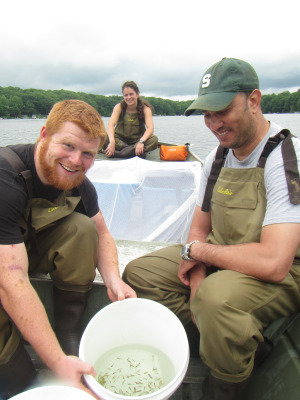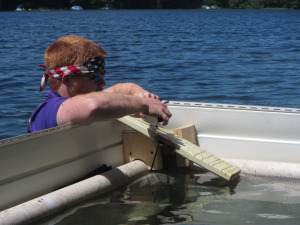Bass research continues at Blue Lake
Add Summary

Joe Nohner is a CSIS PhD student who's studying largemouth bass, specifically how habitat helps baby largemouth survive and grow, and the socioeconomic factors that influence landowners’ habitat management choices. He's also a passionate fisherman who aims to understand the layers and layers of complexity to solve ecosystem problems. This is an excerpt from Joe's blog, Fishing for Habitat.
July 14, 2014
Our big research question is “what habitats do largemouth bass survive best in,” but breaking it down scientifically into testable hypotheses is really tough! One way to approach the question is by confining the fish to particular habitats and seeing how they do. Of course, there are some big assumptions confining mobile fish, but more on that later.
 On July 2, we began our first experiment of this year. We placed 12 net pens in Blue Lake (near Fountain, Mich.) and stocked them each with baby largemouth bass. The net pens are 10 feet by 10 feet, with an open bottom. We put the pens in areas with 0 percent, 50 percent and 100 percent vegetation coverage to see whether the fish grow better or eat differently. Our results from last year suggested that bass in pens with no vegetation grew more slowly. However, we were challenged by a major issue: turtles!
On July 2, we began our first experiment of this year. We placed 12 net pens in Blue Lake (near Fountain, Mich.) and stocked them each with baby largemouth bass. The net pens are 10 feet by 10 feet, with an open bottom. We put the pens in areas with 0 percent, 50 percent and 100 percent vegetation coverage to see whether the fish grow better or eat differently. Our results from last year suggested that bass in pens with no vegetation grew more slowly. However, we were challenged by a major issue: turtles!
The turtles loved to climb on the frame of our nets to warm up in the sun. When they plopped back into the water, they would get into our nets. If they didn’t get out the way they came in, they went for plan B: tear a hole in the net. So, we upped the ante this year and built turtle fences on each net. In case one still happened to get in, we also provided each with a fancy escape ramp. This took four of us about three days to finish up, and is a good example of the random skills you need to conduct this sort of research. Carpentry isn’t a course in Michigan State’s program, but may be required to graduate!
After two weeks in the lake, we have no holes in the nets, and have seen young largemouth bass in each net! So, it looks like some of the problems from last year may be solved. At the end of this month, we will recapture the fish from our nets to determine what they were eating, how fast they grew, and whether they even survived! We’ll compare that to the amount of available food (zooplankton and invertebrates) to determine whether food availability might be the cause for any differences we see.

Hayden installs a turtle emergency exit ramp.

A turtle looks for the way out of our net pen. Just after this picture he used the ramp!



 Print
Print Email
Email





